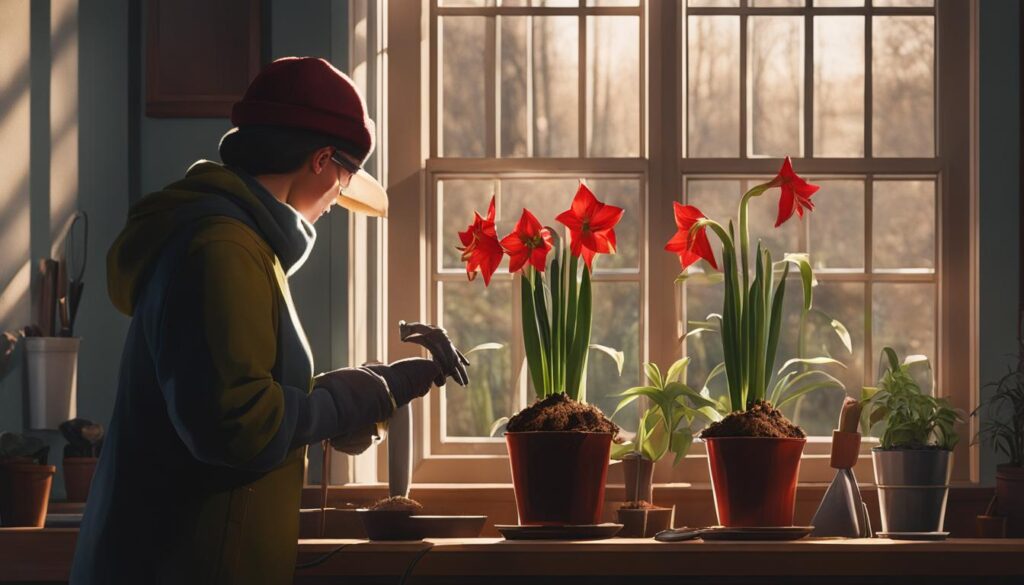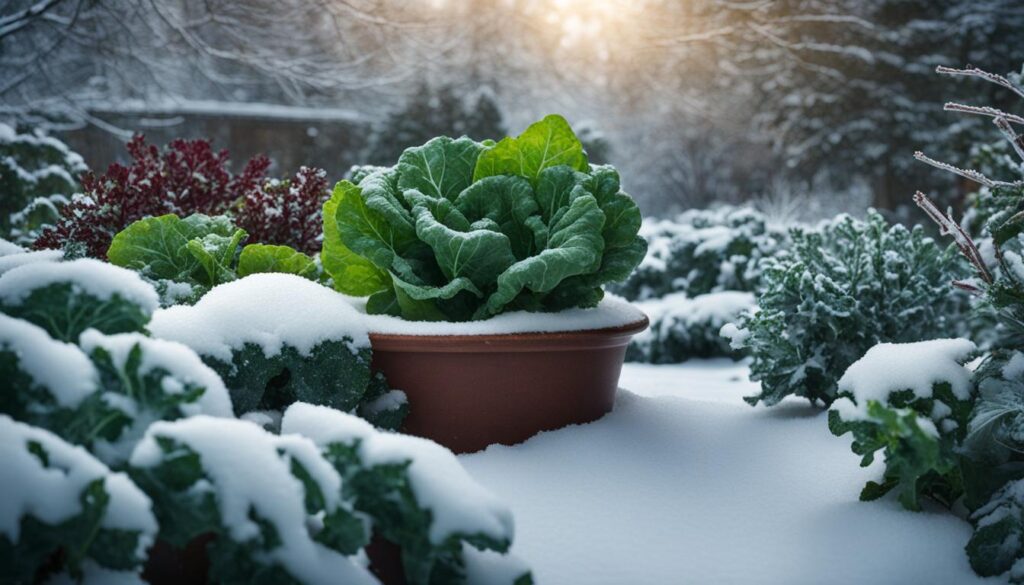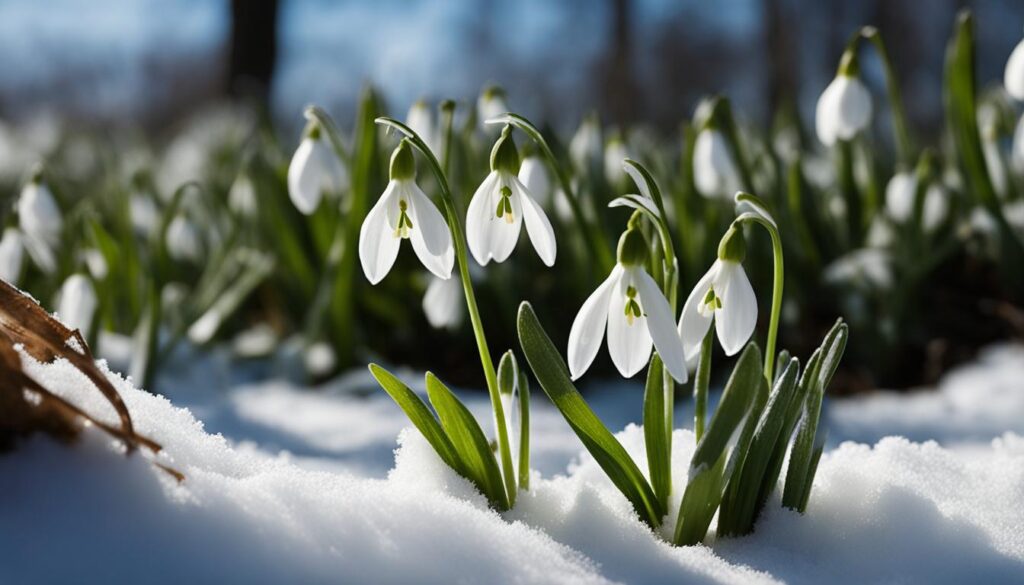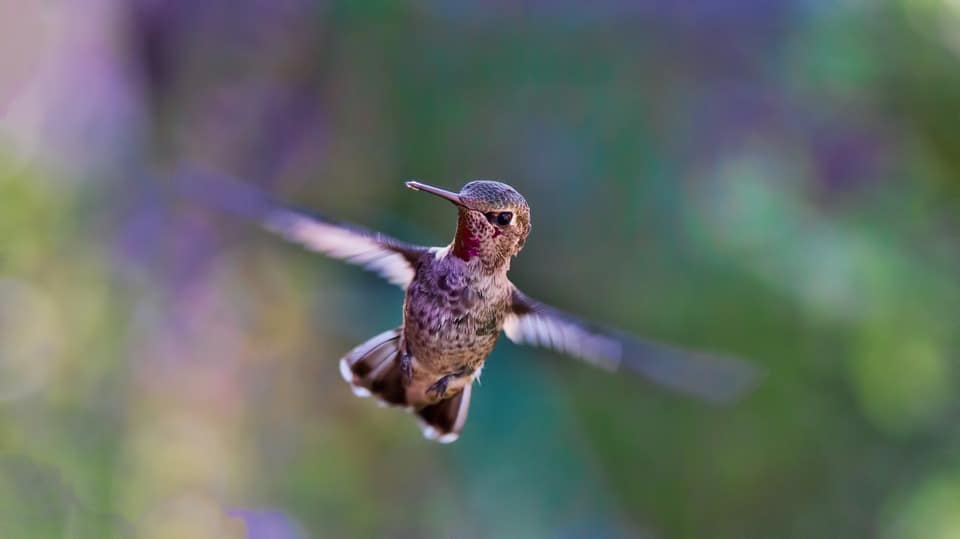January is the perfect time to embrace your green thumb and start planting. Kickstart your gardening year with vibrant plants that thrive in winter. Whether you’re a seasoned gardener or just starting out, these popular plants are ideal for planting in January.
From colorful blooms to hardy vegetables, there’s something for everyone. Let’s dive into the best plants for January planting and get your garden off to a great start.
Amaryllis: A Burst of Winter Color
As the winter months settle in, it’s the perfect time to bring some vibrant colors indoors. One popular choice for winter planting in January is the amaryllis. This potted plant adds a burst of color to any space and brings a touch of joy to the gloomy winter days. Whether you choose to grow it indoors or in a greenhouse, the amaryllis is sure to brighten up your surroundings.
The amaryllis blooms approximately 5 to 8 weeks after planting, making it an ideal choice for those looking for quick results. Its large, showy flowers come in a variety of vibrant hues, including red, pink, white, and even striped varieties. This makes it a versatile plant that can complement any aesthetic or color scheme.
To ensure successful amaryllis planting in January, choose a well-draining potting mix and a container that allows for proper root development. Plant the bulb with about a third of its height above the soil line and place the pot in a bright location with indirect sunlight. Water sparingly until the plant begins to grow, and then increase the frequency as needed.
Hellebore: The Beautiful Winter Flowering Plant
When it comes to winter flowering plants, hellebore stands out as a stunning choice. With its vibrant colors and delicate blooms, it adds a touch of beauty to the winter landscape. Hellebore, also known as the Christmas rose or Lenten rose, is a perennial plant that thrives in the colder months, making it a perfect choice for planting in January.
There are several varieties of hellebore to choose from, each with its own unique charm. From the classic white blooms to shades of pink, purple, and even green, these winter flowers bring a burst of color to gardens and flower beds. The flowers of hellebore often have a nodding or drooping appearance, making them even more enchanting.
Hellebore is a versatile plant that can be planted in various locations in your garden. It thrives in rich, organic soil and prefers a partially shaded area, although it can tolerate some sun. Hellebore is often planted in borders around shrubs and trees, where it adds a touch of elegance and interest to the landscape. It can also be grown in containers, allowing you to enjoy its beauty even in small spaces.
“Hellebores are known for their long-lasting blooms and ability to withstand harsh winter weather. They are a true testament to the resilience and beauty that can be found in nature.” – Gardening expert
The Benefits of Planting Hellebore in January
Planting hellebore in January offers several advantages. Firstly, it allows the plant to establish its root system before the arrival of spring, ensuring a strong and healthy start. This is especially important for perennials like hellebore, as they will continue to bloom year after year.
Secondly, planting hellebore in January gives you a head start on enjoying its gorgeous blooms. While other plants may still be dormant or just starting to show signs of growth, hellebore will already be showcasing its stunning flowers. It’s a wonderful way to bring color and life to your garden during the winter months.
| Hellebore Varieties | Bloom Colors | Height |
|---|---|---|
| Helleborus niger | White | 8-12 inches |
| Helleborus orientalis | Pink, Purple, Green | 18-24 inches |
| Helleborus foetidus | Green | 12-18 inches |
Hardy Plants for January Planting: Beans and Peas
When it comes to planting in January, hardy plants that can withstand cold temperatures are a great choice. Beans and peas are two varieties that not only tolerate the winter chill but also thrive in it. These plants are not only easy to grow but also offer a bountiful harvest that can be enjoyed later in the year.
Peas, such as snap, snow, and English peas, are excellent options for January planting. They are known for their ability to handle low temperatures and even a light frost. By planting them now, you can expect a delicious crop of sweet, crisp peas in the spring.
Another hardy option for winter planting is beans. Fava beans, in particular, are well-suited for January planting. These cold-tolerant legumes can be sown directly into the ground or started indoors and transplanted later. With their sturdy nature, they can withstand chilly conditions and continue to grow steadily.
Winter Flowers: Planting Narcissus in January
When it comes to bringing beauty and color to your winter garden, planting narcissus in January is a fantastic choice. These delicate and fragrant flowers are a welcome sight during the gloomy winter months. Narcissus, also known as daffodils, belong to the Amaryllidaceae family and are known for their vibrant yellow, white, and orange blooms.
One popular variety of narcissus that can be planted in January is the paperwhite narcissus. These flowers are perfect for indoor planting and can be forced to bloom early by providing the right conditions. Paperwhite narcissus bulbs can be grown in bulb vases or planters, and their lovely white blooms will add a touch of elegance to any space.
When planting narcissus bulbs, it’s important to choose a location that receives full or partial sunlight. These flowers prefer well-draining soil and should be planted at a depth of approximately 2-3 inches. Once planted, narcissus bulbs require regular watering to help them establish strong roots. With proper care and maintenance, your narcissus bulbs will reward you with beautiful blooms in late winter or early spring.
Recommended Varieties of Narcissus for January Planting
| Variety | Bloom Color | Planting Depth | Light Requirements |
|---|---|---|---|
| Paperwhite | White | 2-3 inches | Full or partial sunlight |
| Tête-à-Tête | Yellow | 4-6 inches | Full or partial sunlight |
| Ice Follies | White with yellow center | 4-6 inches | Full or partial sunlight |
Planting narcissus in January not only adds beauty to your garden but also gives you a head start on the spring season. These hardy flowers are known for their ability to withstand cold temperatures and their resilience in various growing conditions. Whether you choose to plant them indoors or outdoors, narcissus plants are sure to bring joy and vibrancy to your winter garden.
Greens: The Perfect Winter Vegetables for Planting in January
When it comes to winter gardening, don’t underestimate the power of greens. These versatile vegetables are not only packed with nutrients but also thrive in colder temperatures. By planting greens in January, you can enjoy a bountiful harvest throughout the season. Whether you have a small backyard or a balcony garden, greens are a great choice for winter planting.
Benefits of Planting Greens in January
Planting greens in January offers several advantages. First and foremost, it allows you to extend your growing season and enjoy fresh, homegrown produce even in the colder months. Greens like lettuce, chard, and arugula are cold-hardy and can withstand frost, making them excellent choices for winter gardening. Additionally, growing greens in January helps to enrich the soil and prevent erosion, as their roots help to hold the soil in place during periods of heavy rain or snow.
“Winter gardening is not only a great way to supplement your meals with fresh greens, but it also allows you to stay connected with nature and enjoy the therapeutic benefits of gardening all year round.”
Greens to Consider for January Planting
Here are some popular greens that you can plant in January:
- Lettuce: Look for varieties like romaine, butterhead, and mesclun mix, which are cold-tolerant.
- Chard: This leafy green is not only nutritious but also adds vibrant colors to your garden.
- Arugula: Known for its peppery flavor, arugula is a fast-growing green that can be enjoyed in salads or as a garnish.
Remember to choose varieties that are suitable for your specific climate and consider using row covers or cold frames to provide extra protection during extreme weather conditions. Regularly monitor the moisture levels of the soil and adjust watering accordingly to ensure the health and growth of your greens.
| Greens | Planting Tips |
|---|---|
| Lettuce | Plant in well-drained soil and provide ample sunlight. Harvest outer leaves as needed. |
| Chard | Choose a location with partial shade for best results. Harvest outer leaves when they reach approximately 8 inches in length. |
| Arugula | Sow seeds directly into the soil and thin the seedlings to ensure proper spacing. Harvest when the leaves are young and tender. |
By incorporating greens into your winter garden, you not only ensure a fresh supply of nutritious vegetables but also add beauty and variety to your outdoor space. So, grab your gardening tools and get ready to plant some greens this January!
Hearty Winter Blooms: Snowdrops Planting in January
Even in the midst of winter, you can enjoy the beauty of blooming flowers in your garden. Snowdrops, with their delicate white petals, are the perfect choice for a splash of color during the colder months. Planting snowdrops in January will ensure that you have a stunning display of these hearty winter blooms in early spring.
Snowdrops are known for their ability to withstand freezing temperatures and even bloom through the snow. These resilient plants symbolize hope and rebirth, making them a wonderful addition to any garden. Not only do snowdrops add aesthetic appeal, but they also provide an early source of nectar for bees and other pollinators.
“Snowdrops are like a ray of sunshine in the winter garden. Their simple yet elegant flowers bring joy and optimism during the coldest months of the year.”
When planting snowdrops in January, it’s important to choose a location that receives partial shade and has well-draining soil. Dig a hole that is two to three inches deep and place the bulbs with the pointed end facing upwards. Space the bulbs about three inches apart, as snowdrops tend to naturalize and form beautiful clusters over time.
| Planting Depth | Spacing | Sun Exposure | Soil Type |
|---|---|---|---|
| 2-3 inches | 3 inches apart | Partial shade | Well-draining |
Once planted, water the bulbs thoroughly and provide a layer of mulch to protect them from extreme temperatures. Snowdrops are relatively low-maintenance and will continue to bloom year after year. They are a wonderful addition to winter gardens, bringing a touch of elegance and beauty even when the weather is cold and dreary.
Benefits of Snowdrops Planting in January
- Adds a splash of color to the winter garden
- Provides early nectar for bees and pollinators
- Symbols of hope and rebirth
- Thrives in partial shade and well-draining soil
- Low-maintenance and naturalizes over time
With their delicate beauty and resilience, snowdrops are a wonderful choice for winter gardening. By planting snowdrops in January, you can enjoy the sight of these hearty winter blooms and eagerly anticipate the arrival of spring.
Asparagus: A Nutritious and Delicious Early Spring Vegetable
If you’re looking to jumpstart your spring garden, planting asparagus in January is a great choice. This nutritious and delicious vegetable is a favorite among gardeners and food enthusiasts alike. With its vibrant green spears and unique flavor, asparagus is a versatile ingredient that can be enjoyed in a variety of dishes. But what makes it an ideal early spring vegetable?
Asparagus thrives in cooler temperatures and can tolerate light frost, making it the perfect vegetable to plant in January. By starting early, you’ll be able to enjoy a bountiful harvest of tender spears in the early spring when other vegetables are just starting to grow. Plus, asparagus is a perennial plant, meaning that with proper care and maintenance, it can continue to produce for up to 15 years.
When planting asparagus, it’s important to choose a sunny spot with well-draining soil. Asparagus plants prefer slightly acidic soil, so it’s a good idea to test your soil’s pH levels before planting. Once you’ve prepared the soil, dig trenches about 6-8 inches deep and plant the crowns (the root systems of the asparagus) about 12-18 inches apart. Cover the crowns with a few inches of soil and water thoroughly.
| Benefits of Planting Asparagus in January | Tips for Successful Asparagus Planting |
|---|---|
|
|
Asparagus is not only a delicious addition to your garden but also a nutritious one. It’s packed with essential vitamins and minerals, including vitamins A, C, and K, as well as folate and fiber. Incorporating asparagus into your diet can support a healthy immune system, improve digestion, and promote overall well-being.
Whether you’re a seasoned gardener or a beginner, planting asparagus in January is a rewarding experience. Not only will you enjoy the early spring harvest, but you’ll also have a long-term supply of this versatile and nutritious vegetable. So, roll up your sleeves, grab your gardening tools, and get ready to plant some asparagus!
Indoor Bulb Planting: Bring a Touch of Spring to Your January with Daffodils
If you’re looking to add a burst of color and a hint of spring to your home during the gloomy winter months, planting daffodil bulbs indoors in January is the perfect solution. Daffodils are a popular bulb plant that blooms in early spring, but with a little planning, you can enjoy their vibrant flowers indoors long before the weather warms up.
To get started, choose a suitable container for your daffodil bulbs. A shallow pot with good drainage is ideal. Fill the pot with well-draining soil, leaving enough space for the bulbs to be planted. Gently press the bulbs into the soil, pointed end up, and cover them with soil, leaving the top third of the bulb exposed.
Place the pot in a bright location with indirect sunlight, such as a sunny window sill. Water the bulbs lightly, keeping the soil moist but not overly saturated. Within a few weeks, you’ll start to see green shoots sprouting from the bulbs, followed by beautiful blooms in various shades of yellow, white, and orange.
Indoor daffodils can bring a breath of fresh air and a touch of spring to any indoor space. Whether displayed as a centerpiece on your dining table or arranged in pots throughout your home, these stunning flowers will brighten up even the gloomiest winter days.
Tips for Indoor Daffodil Planting
| Tip | Description |
|---|---|
| Choose the right bulbs | Look for healthy, firm bulbs without any signs of mold or damage. |
| Provide adequate sunlight | Place the pot in a bright location with indirect sunlight for optimal growth. |
| Water sparingly | Avoid overwatering the bulbs, as excessive moisture can cause rotting. |
| Rotate the pot | To promote even growth, rotate the pot every few days to ensure all sides of the plant receive light. |
| Enjoy the blooms | Once the daffodils bloom, trim the stems and place them in a vase with fresh water to enjoy their beauty and fragrance. |
Planting daffodil bulbs indoors in January is a rewarding way to bring the joy and beauty of spring into your home. With proper care and attention, you’ll soon be enjoying a vibrant display of daffodil blooms, even before winter has loosened its grip on the outdoors.
Winter Planting in Warmer Climates: Peonies Planting in January
If you live in a warmer climate with minimal frosts, you have the opportunity to plant peonies in January and enjoy their beautiful blooms. Peonies are typically planted in late autumn, but in regions where winters are mild, planting them in January can yield stunning results. With their large, showy flowers and delightful fragrance, peonies can add a touch of elegance to any garden or landscape.
Peonies prefer well-drained soil and a location that receives at least six hours of direct sunlight each day. Before planting, prepare the soil by adding organic matter, such as compost or well-rotted manure, to improve its texture and fertility. Dig a hole that is wide and deep enough to accommodate the peony root system, ensuring that the eyes (buds) are planted no more than two inches below the soil surface.
Recommended Peony Varieties for Warmer Climates
| Variety | Bloom Color | Flower Form | Bloom Time |
|---|---|---|---|
| Angel Cheeks | Pink | Semi-double | Midseason |
| Coral Charm | Orange | Semi-double | Early to Midseason |
| Garden Treasure | Yellow | Semi-double | Early to Midseason |
| My Love | White | Double | Midseason |
Once planted, water the peony thoroughly and apply a layer of mulch around the plant to help retain moisture and suppress weeds. Water regularly during dry spells and avoid overwatering, as peonies prefer slightly moist soil. In warmer climates, it’s important to protect the peonies from intense midday sun by providing shade or planting them in a location that receives filtered sunlight during the hottest part of the day.
With proper care and attention, peonies planted in January can establish strong root systems and produce breathtaking blooms in the coming spring. Remember to provide support for the heavy flower heads as they develop, using stakes or a peony ring to prevent them from bending or breaking. By adding peonies to your winter planting list, you can create a stunning garden that thrives even in warmer climates.
Winter Vegetables: Planting Kale in January
If you’re looking to add some nutritious and delicious greens to your winter garden, kale is an excellent choice. This hardy vegetable thrives in cooler temperatures and can be planted in January to ensure a bountiful harvest later in the season. Here are some key details to keep in mind when planting kale in January:
The Best Varieties for Winter Planting
When selecting kale varieties for winter planting, look for those that are known for their cold tolerance and ability to withstand frost. Some popular choices include:
- White Russian
- Siberian
- Winterbor
These varieties are well-suited for milder climates during the winter months and can also be started as seedlings in a greenhouse for transplanting in early spring.
Planting and Care Tips
Here are some important tips to consider when planting and caring for kale:
- Choose a sunny location with well-drained soil.
- Prepare the soil by incorporating organic matter, such as compost or aged manure, to improve fertility and drainage.
- Sow kale seeds directly in the garden, about half an inch deep and one to two feet apart.
- Water the plants regularly, keeping the soil consistently moist but not waterlogged.
- Apply a layer of mulch around the plants to help conserve moisture and suppress weed growth.
- Protect the plants from extreme cold by covering them with row covers or cloches.
Harvesting and Using Kale
Kale is a versatile vegetable that can be harvested and enjoyed throughout the winter months. To harvest, simply remove the outer leaves, allowing the inner leaves to continue growing. Younger leaves tend to be more tender and can be used fresh in salads, while older leaves are excellent for sautéing, steaming, or adding to soups and stews.
| Planting Month | Harvest Month |
|---|---|
| January | March-April |
| February | April-May |
| March | May-June |
| April | June-July |
By following these planting and care tips, you can enjoy a steady supply of fresh, nutrient-rich kale throughout the winter months. Whether you’re adding it to soups, stir-fries, or salads, kale is a versatile and healthy addition to any kitchen.
Root Vegetables: A Perfect Choice for Winter Planting
When it comes to winter gardening, root vegetables are a fantastic option. Not only are they hardy and able to withstand the cold temperatures, but they also provide a delicious addition to winter soups and stews. January is an ideal time to plant root vegetables, as the chilly weather helps enhance their flavor and sweetness. Whether you have a small backyard garden or a few pots on your balcony, here are some popular root vegetables to consider planting in January:
Carrots
Carrots are a staple root vegetable that can be grown in both traditional vegetable gardens and containers. They come in a variety of colors, from classic orange to vibrant purple and yellow. Carrots are rich in vitamins and antioxidants, making them a nutritious addition to your winter meals. To ensure good growth, plant carrot seeds in well-draining soil and keep the area weed-free.
Turnips
Turnips have a slightly peppery flavor and are often used in soups, stews, and roasted vegetable medleys. They are easy to grow and can be sown directly into the ground or in containers. Turnips prefer cool weather, making January the perfect time to plant them. Regular watering and fertilization will help them thrive.
Radishes
Radishes are known for their quick growth and vibrant colors. They can be planted in January and will be ready to harvest in just a few weeks. Radishes are a great addition to salads, sandwiches, and pickling recipes. Ensure their soil is well-drained and provide consistent moisture for optimal growth.
Parsnips
Parsnips are sweet and nutty in flavor, making them a delicious addition to winter dishes. They require a longer growing period compared to other root vegetables, so January is the perfect time to plant them for a late winter harvest. Parsnips prefer loose, well-drained soil and consistent watering.
| Root Vegetable | Best Month to Plant | Harvest Time |
|---|---|---|
| Carrots | January | 60-80 days |
| Turnips | January | 30-60 days |
| Radishes | January | 20-30 days |
| Parsnips | January | 120-150 days |
Planting root vegetables in January not only allows you to enjoy a winter harvest but also helps extend the growing season. Make sure to follow the planting instructions specific to each root vegetable to ensure successful growth. With proper care and attention, you can have a bountiful harvest of nutritious and flavorful root vegetables to enjoy throughout the winter months.
Can Chives Be Planted in January Along with Other Popular Plants?
Yes, chives can be planted in January along with other popular plants. These herbs that grow well can thrive in cool weather and can be grown indoors during the winter months. They are a great addition to your herb garden and can be used in a variety of culinary dishes.
Summing Up
January is a great time to start planting a variety of popular plants. Whether you’re looking to add a burst of color with blooms like amaryllis and hellebore, or you’re eager to grow hardy vegetables like peas and kale, there are plenty of options to ensure your garden thrives all year round. Take advantage of the winter months and get a head start on your gardening year.
Adding vibrant plants to your garden in January is a wonderful way to kickstart your year and bring beauty to the winter months. From the stunning colors of amaryllis and hellebore to the sturdy greens and root vegetables, there’s something for everyone’s taste. Whether you have a small space or a sprawling garden, planting now will ensure a bountiful harvest and a vibrant landscape.
So, grab your gardening tools, prepare your soil, and get ready to enjoy the rewards of your hard work. January is the perfect time to dive into the world of gardening, and with a variety of popular plants to choose from, you’ll have a thriving garden in no time. Embrace the cold weather and turn it into an opportunity to nurture and grow beautiful plants that will bring joy and beauty to your surroundings.

















